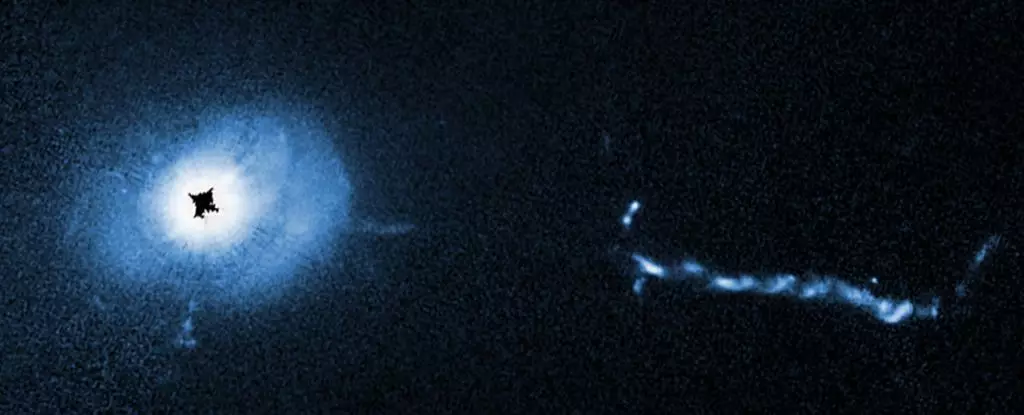Quasars, abbreviated from “quasi-stellar objects,” stand out as some of the brightest phenomena in the universe, captivating astronomers and astrophysicists for decades. These extraordinary objects are powered by supermassive black holes residing at the centers of galaxies and shine with incredible luminosity due to the intense gravitational forces at play. As gas and dust spiral into these black holes — a process known as accretion — they form a rotating disk that heats up, emitting staggering amounts of light across various electromagnetic spectra. This fascinating interplay between gravity, light, and matter creates an illuminating spectacle that allows scientists to study the universe in ways previously thought impossible. Quasar 3C 273, located approximately 2.5 billion light-years away, has emerged as a focal point for understanding these enigmatic entities.
A Close Encounter with 3C 273
The latest observations made using the Hubble Space Telescope have gifted astronomers with an unprecedented view of 3C 273. Although not the closest quasar to Earth, its remarkable brightness positions it as an essential target for examining the dynamics of quasars. The detailed imaging achieved through Hubble’s observations sheds light on the intricate structures surrounding this quasar, offering new insights and serving as a validation for innovative methods used in quasar research. The excitement among scientists is palpable, as many felt they were finally able to see a level of detail that was previously obscured by the overwhelming brightness of the quasar itself.
To capture the elusive features of 3C 273, astronomers employed a novel technique using the Space Telescope Imaging System (STIS). By creating a makeshift coronagraph, they effectively obscured the intense light emitted by the quasar, akin to shading one’s eyes to mitigate the glare from a direct light source. This ingenious method allowed researchers to unravel the intricate layers of the surrounding structures that had remained hidden – a crucial step in enhancing our understanding of these cosmic giants. The new imaging is reported to be eight times finer than any prior observations, revealing remarkable features within a radius of 16,000 light-years from the quasar’s core.
Recent findings from Hubble’s observations of 3C 273 have revealed some exciting new structures. One particularly intriguing aspect is the identification of small blobs, possibly representing satellite galaxies or remnants of materials being pulled into the quasar. In addition, astronomers discovered an enigmatic L-shaped filament, the nature of which is still unknown, adding another layer of mystery to this cosmic puzzle. Moreover, they were able to gather new measurements related to the astrophysical jet originating from the supermassive black hole’s external magnetic field, which extends an astonishing 300,000 light-years into intergalactic space.
These discoveries pave the way for scientists to develop deeper analyses of quasar mechanics and interactions with their environments. The understanding of jet motions revealed that they tend to accelerate as they move away from the black hole, prompting further inquiries into the dynamics and mechanisms that govern these jets. Such information is invaluable in piecing together the elaborate picture of quasar activity.
The revelations stemming from the study of 3C 273 extend well beyond this single quasar. Bin Ren of the Côte d’Azur Observatory stressed the significance of Hubble’s findings in bridging gaps between various observational methodologies in quasar research. By combining insights from high-resolution radio data and optical imaging, astronomers are beginning to forge a more comprehensive understanding of quasar host morphology. The previous perspectives on quasars were limited and often muddled by the overpowering luminosity, but with Hubble’s help, they are starting to decode the complexities of both the morphology of quasars and their interactions with neighboring galaxies.
The continued exploration of quasars like 3C 273 not only quenches our thirst for knowledge about celestial mechanics but also enhances our grasp of the mechanisms underpinning the universe’s most powerful phenomena. Each observation raises new questions and offers fresh avenues of inquiry, underscoring the importance of tools like the Hubble Space Telescope in pushing the boundaries of our cosmic understanding. As astronomers sift through these new data, they embark on an exciting journey destined to reveal even more secrets of the universe, one quasar at a time.


Leave a Reply